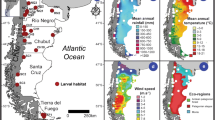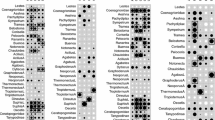Abstract
The aquatic bodies designated as mosquito larval habitats are diverse in size and species composition. The macroinvertebrate predators in these habitats are elements that influence the abundance of mosquito species, providing a basis for biological control. Assessment of species assemblage in these habitats will indicate the possible variations in the resource exploitation and trophic interactions and, therefore, can help to frame biological control strategies more appropriately. In the present study, the species composition is being investigated in five different mosquito larval habitats at a spatial scale. A random sample of 80 each of the habitats, grouped as either small or large, was analyzed in respect to the macroinvertebrate species assemblage. The species composition in the habitats was noted to be an increasing function of habitat size (species number = 1.653 + 0.819 habitat size) and, thus, the diversity. The relative abundance of the mosquito immatures varied with the habitat, and the number of useful predator taxa was higher in the larger habitats. In the smaller habitats—plastic and earthen structures and sewage drains, the relative and absolute number of mosquito immatures per sampling unit were significantly higher than the pond and rice field habitats. This was evident in the cluster analysis where the smaller habitats were more related than the larger habitats. The principal component analysis on the species diversity yielded four and six components, respectively, for the smaller and larger habitats for explaining the observed variance of species abundance. The species composition in the habitats was consistent with the earlier findings and support that the abundance of coexisting macroinvertebrate species regulates the relative load of mosquito immatures in the habitats. The findings of this study may be further tested to deduce the relative importance of the habitats in terms of the productivity of mosquito immatures at a temporal scale.
Similar content being viewed by others
References
Addinsoft, S. A. R. L. (2009). XLSTAT software, version 9.0. Paris, France.
Aditya, G., Pramanik, M. K., & Saha, G. K. (2006). Larval habitats and species composition of mosquitoes in Darjeeling Himalayas. Journal of Vector Borne Diseases, 43, 7–15.
Aditya, G., Tamang, R., Sharma, D., Subba, F., & Saha, G. K. (2008). Bamboo stumps as mosquito larval habitats in Darjeeling Himalayas, India – a spatial scale analysis. Insect Science, 15, 245–249. doi:10.1111/j.1744–7917.2008.00207.
Alto, B. W., Griswold, M. W., & Lounibos, L. P. (2005). Habitat complexity and sex dependent predation of mosquito larvae in containers. Oecologia, 146, 300–310. doi:10.1007/s00442–005–0198-x.
Balcombe, C. K., Anderson, J. T., Fortney, R. H., & Kordek, W. S. (2005). Aquatic macroinvertebrate assemblages in mitigated and natural wetlands. Hydrobiologia, 541, 175–188. doi:10.1007/s10750–004–5706–1.
Bambaradeniya, C. N. B., Edirisinghe, J. P., De Silva, D. N., Gunatilleke, C. V. S., Ranawana, K. B., & Wijekoon, S. (2004). Biodiversity associated with an irrigated rice agro-ecosystem in Sri Lanka. Biodiversity and Conservation, 13, 1715–1753. doi:10.1023/B:BIOC0000029331.92656.de.
Barraud, P. J. (1934). Fauna of British India, including Ceylon and Burma. Diptera (Family culicidae: Tribes megarginini and culicini) (Vol V). London, UK: Taylor and Francis.
Blaustein, L., & Chase, J. M. (2007). Interactions between mosquito larvae and species that share the same trophic level. Annual Review of Entomology, 52, 489–507. doi:10.1146/annurev.ento.52.110405.091431.
Blaustein, L., Kiflawi, M., Eitam, A., Mangel, M., & Cohen, J. E. (2004). Oviposition habitat selection in response to risk of predation in temporary pools: Mode of detection and consistency along experimental venue. Oecologia, 138, 300–305. doi:10.1007/s00442–003–1398.
Burdett, A. S., & Watts, R. J. (2009). Modifying living space: An experimental study of the influences of vegetation on aquatic invertebrate community structure. Hydrobiologia, 618, 161–173. doi:10.1007/s10750–008–9573-z.
Campos, R. E., Fernandez, I. A., & Sy, V. E. (2004). Study of the insects associated with the floodwater mosquito Ochlerotahus albifasciatus (Diptera Culicidae) and their possible predators in Buenos Aires province. Hydrobiologia, 524, 9–10. doi:10.1023/B:HYDR0000036122.10578.d0.
Carlson, J., Keating, J., Mbogo, C. M., Kahindi, S., & Beier, J. C. (2004). Ecological limitations on the aquatic mosquito predator colonization in the urban environment. Journal of Vector Ecology, 29, 331–339.
Christophers, S. R. (1933). The fauna of British India including Ceylon and Burma (Vol IV). London, UK: Taylor and Francis.
Das, P. K., Sivagnaname, N., & Amalraj, D. D. (2006). Population interactions between Culex vishnui mosquitoes and their natural enemies in Pondicherry, India. Journal of Vector Ecology, 29, 188–191.
De Szalay, F. A., & Resh, V. H. (2000). Factors influencing macroinvertebrate colonization of seasonal wetlands: Responses to emergent plant cover. Freshwater Biology, 45, 295–308. doi:10.1111/j.1365–2427.2000.00623.x.
Eitam, A., & Blaustein, L. (2004). Oviposition habitat selection by mosquitoes in response to predator (Notonecta maculata) density. Physiological Entomology, 29, 188–191. doi:10.1111/j.0307–6962.2004.0372.x.
Fincke, O. M. (1999). Organization of predator assemblages in Neotropical tree holes: Effects of abiotic factors and priority. Ecological Entomology, 24, 13–23. doi:10.1046/j.1365–2311.1999.00166.x.
Fischer, S., Marinone, M. C., Fontanarrosa, M. S., Nieves, M., & Schweigmann, N. (2000). Urban rain pools: Seasonal dynamics and entomofauna in a park of Buenos Aires. Hydrobiologia, 444, 45–63. doi:10.1007/BF00028052.
Garcia, R. (1983). Mosquito management: Ecological approaches. Environmental Management, 7, 73–78. doi:10.1007/BF01867044.
Gilbert, B., Srivastava, D. S., & Kirby, K. R. (2008). Niche partitioning at multiple scales facilitates coexistence among mosquito larvae. Oikos, 117(6), 944–950. doi:10.1111/j.0030–1299.2008.16300.x.
Irwin, P., Arcari, C., Hausbeck, J., & Paskewitz, S. (2008). Urban wet environment as mosquito habitat in upper Midwest. EcoHealth, 5, 49–57. doi:10.1007/s10393–007–0152-y.
Jacob, B. G., Muturi, E. J., Funes, J. E., Shililu, J. I., Githure, J. I., Kakoma, I. I., et al. (2006a). A grid-based infrastructure for ecological forecasting of Riceland Anopheles arabiensis aquatic larval habitats. Malaria Journal, 5, 91. doi:10.1186/1475–2875–5–91.
Jacob, B. G., Shililu, J., Muturi, E. J., Mwangangi, J. M., Muriu, S. M., Funes, J., et al. (2006b). Spatially targeting Culex quinquefasciatus aquatic habitats on modified land cover for implementing an Integrated Vector Management (IVM) program in three villages within the Mwea Rice Scheme, Kenya. International Journal of Health Geographics, 5, 18. doi:10.1186/1476–072X-5–18.
Jeffries, M. J. (2002). Evidence for individualistic species assembly creating convergent predator-prey ratios among pond invertebrate communities. Journal of Animal Ecology, 71, 173–184. doi:10.1046/j.1365–2656.2002.00587.x.
Keating, J., Macintyre, K., Mbogo, C. M., Githure, J. I., & Beier, J. C. (2004). Characterization of potential larval habitats for Anopheles mosquitoes in relation to urban land-use in Malindi, Kenya. International Journal of Health Geographics, 3, 9. doi:0.1186/0.1186/1476–072X-3–9.
Kiflawi, M., Blaustein, L., & Mangel, M. (2003). Predation-dependent oviposition habitat selection by the mosquito Culiseta longiareolata: A test of competing hypotheses. Ecology Letters, 6, 35–40. doi:10.1046/j.1461–0248.2003.00385.x.
Kinnear, P. R., & Gray, C. D. (2000). SPSS for Windows made simple. Release 10. Sussex, UK: Psychology Press.
Kitching, R. L. (2001). Foodwebs in phytotelmata: “Bottom-up” and “top-down” explanations for community structure. Annual Review of Entomology, 46, 729–60. doi:10.1146/annurev.ento.46.1.729.
Knight, R. L., Walton, W. E., O’Meara, G. F., Reisen, W. K., & Wass, R. (2003). Strategies for effective mosquito control in constructed treatment wetlands. Ecological Engineering, 21, 211–232. doi:10.1016/j.ecoleng.2003.11.001.
Krebs, C. J. (1999). Ecological methodology (2nd ed.). New York, USA: Benjamin Cummings.
Leitão, S., Pinto, P., Pereira, T., & Brito, M. F. (2007). Spatial and temporal variability of macroinvertebrate communities in two farmed Mediterranean rice fields. Aquatic Ecology, 41, 373–386. doi:10.1007/s10452–007–9082–6.
Ludwig, J. A., & Reynolds, J. F. (1988). Statistical ecology: A primer on methods and computing. NewYork, USA: John Wiley & Sons.
McDonald, G., & Buchanan, G. A. (1981). The mosquito and predatory insect fauna inhabiting fresh-water ponds, with particular reference to Culex annulirostris Skuse (Diptera: Culicidae). Australian Journal of Ecology, 6, 21–27. doi:10.1111/j.1442–9993.1981.tb01270.x.
Mogi, M., Memah, V., Miyagi, I., Toma, T., & Sembel, D. T. (1995). Mosquito and aquatic predator abundance in irrigated and rain fed rice fields in north Sulawesi, Indonesia. Journal of Medical Entomology, 32, 361–367.
Mogi, M., Sunahara, T., & Selemo, M. (1999). Mosquito and aquatic predator communities in ground pools on lands deforested for rice-field development in central Sulawesi, Indonesia. Journal of the American Mosquito Control Association, 15, 92–97.
Naeem, S. (1988). Predator-prey interactions and community structure: Chironomids, mosquitoes and copepods in Heliconia imbricata (Musaceae). Oecologia, 77, 202–209. doi:10.1007/BF00379187.
Nagpal, B. N., Srivastava, A., Saxena, R., Ansari, M. A., Dash, A. P., & Das, S. C. (2005). Pictorial identification key for Indian anophelines. New Delhi, India: Malaria Research Centre, (ICMR).
Overtli, B., Joye, D. A., Castella, E., Juge, R., Cambin, D., & Lachavanne, J.-B. (2002). Does size matter? The relationship between pond area and biodiversity. Biological Conservation, 104, 59–70. doi:10.1016/S0006–3207(01)00154–9.
Pramanik, M. K., & Raut, S. K. (2003). Occurrence of the giant mosquito Toxorhynchites splendens in drains and its predation potential on some vector mosquitoes of Kolkata (Calcutta), India. Medical Entomology and Zoology, 54, 315–323.
Pramanik, M. K., Aditya, G., & Raut, S. K. (2007). Seasonal prevalence of Aedes aegypti immatures in Kolkata, India. Southeast Asian Journal Tropical Medicine and Public Health, 38, 442–447.
Robert, V., Goff, G., Ariey, F., & Duchemin, J. B. (2002). A possible alternative method for collecting mosquito larvae in rice fields. Malaria Journal, 1, 4. doi:10.1186/1475–2875–1–4.
Saha, N., Aditya, G., Bal, A., & Saha, G. K. (2008). Light and habitat structure influences predation of Culex quinquefasciatus larvae by the water bugs (Hemiptera: Heteroptera). Insect Science, 15, 461–469. doi:10.1111/j.1744–7917.2008.00234.x.
Saha, N., Aditya, G., & Saha, G. K. (2009). Habitat complexity reduces vulnerability of prey: An experimental analysis using aquatic insect predators and dipteran immatures. Journal of Asia Pacific Entomology. doi:10.1016/j.aspen.2009.06.00.
Spencer, M., Blaustein, L., & Cohen, J. E. (2002). Oviposition habitat selection by mosquitoes (Culiseta longiareolata) and consequences for population size. Ecology, 83, 669–679. doi:10.1890/0012–9658(2002)083[0669:OHSBMC]2.0.CO;2.
Srivastava, D. (2006). Habitat structure, trophic structure and ecosystem function: Interactive effects in a bromeliad–insect community. Oecologia, 149, 493–504. doi:10.1007/s00442–006–0467–3.
Sunahara, T., Ishizaka, K., & Mogi, M. (2002). Habitat size: A factor determining the opportunity for encounters between mosquito larvae and aquatic predators. Journal of Vector Ecology, 27, 8–20.
Sunish, I. P., & Reuben, R. (2002). Factors influencing the abundance of Japanese encephalitis vectors in rice field in India - II. Biotic. Medical and Veterinary Entomology, 16, 1–9. doi:10.1046/j.1365–2915.2002.00325.x
Thullen, J. S., Sartoris, J. J., & Walton, W. E. (2002). Effects of vegetation management in constructed wetland treatment cells on water quality and mosquito production. Ecological Engineering, 18, 441–457. doi:10.1016/SO925–8574(01)00105–7.
Victor, T. J., & Reuben, R. (1999). Population dynamics of mosquito immatures and the succession in abundance of aquatic insects in rice fields in Madurai, south India. Indian Journal of Malariology, 36, 19–32.
Victor, T. J., & Reuben, R. (2000). Effects of organic and inorganic fertilizers on mosquito populations in ricefields of southern India. Medical and Veterinary Entomology, 14, 361–368. doi:10.1111/j.1365-2915.2000.00255.x.
Willott, E. (2004). Restoring nature, without mosquitoes? Restoration Ecology, 12, 147–153. doi:10.1111/j.1061–2971.2004.00392.x.
Wilson, A. L., Watts, R. J., & Stevens, M. M. (2007). Effects of different management regimes on aquatic macroinvertebrate diversity in Australian rice fields. Ecological Research, 23, 565–572. doi:10.1007/s11284-007–0410-z.
Yanoviak, S. P. (2001). Predation, resource availability, and community structure in Neotropical water filled tree holes. Oecologia, 126, 125–133. doi:10.1007/s004420000493.
Yee, D. A., & Juliano, S. A. (2007). Abundance matters: A field experiment testing the more individuals hypothesis for richness–productivity relationships. Oecologia, 153, 153–162. doi:10.1007/s00442–007–0707–1.
Yee, D. A., Kaufman, M. G., & Juliano, S. A. (2007a). The significance of ratios of detritus types and microorganism productivity to competitive to competitive interactions between aquatic insect detritivores. Journal of Animal Ecology, 76, 1105–1115. doi:10.1111/j.1365–2656.2007.01297.x.
Yee, D. A., Yee, S. H., Kneitel, J. M., & Juliano, S. A. (2007b). Richness–productivity relationships between trophic levels in a detritus-based system: Significance of abundance and trophic linkage. Oecologia, 154, 377–385. doi:10.1007/s00442–007–0837–5.
Zar, J. H. (1999). Biostatistical analysis (4th ed.). New Delhi, India: Pearson Education (Singapore) Pte Ltd., (Indian Branch).
Author information
Authors and Affiliations
Corresponding author
Rights and permissions
About this article
Cite this article
Banerjee, S., Aditya, G., Saha, N. et al. An assessment of macroinvertebrate assemblages in mosquito larval habitats—space and diversity relationship. Environ Monit Assess 168, 597–611 (2010). https://doi.org/10.1007/s10661-009-1137-9
Received:
Accepted:
Published:
Issue Date:
DOI: https://doi.org/10.1007/s10661-009-1137-9




